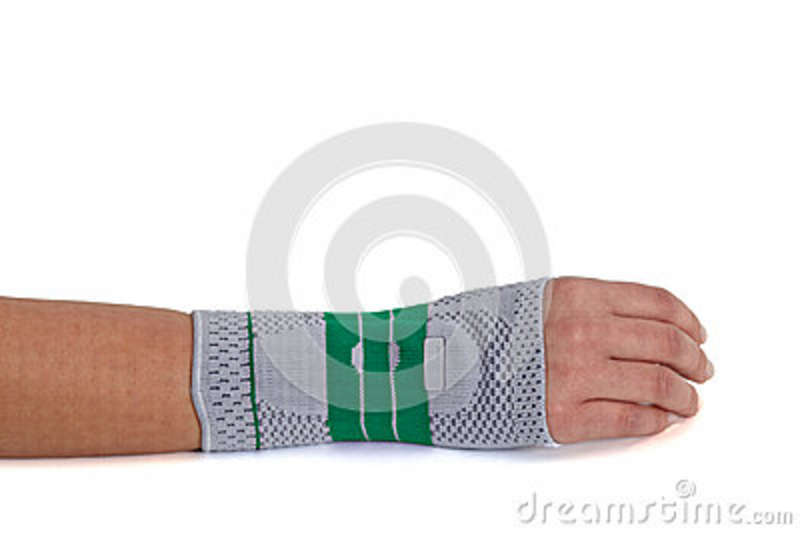Carpal tunnel syndrome (CTS) is a disorder that affects the hand and wrist. It occurs when the median nerve hich runs through the wrist is compressed, causing such symptoms as changes in sensation, pain, and restricted use of the hand.
Carpal tunnel syndrome most commonly occurs in women, with those aged between 30 and 60 years having the highest rates of the condition. Initial treatment aims to reduce and manage symptoms without surgery but if this is unsuccessful, surgery may be recommended.
Signs and symptoms
The onset of CTS symptoms is usually gradual and can affect either one or both hands. The most common symptoms are numbness and tingling of the hand and fingers. Other symptoms may include:
- Burning, prickly, pin-like sensations in the hand and fingers
- Hand stiffness – particularly in the morning
- A feeling of swelling in the fingers – even though they may not be visibly swollen
- Wasting of the muscles in the hand can occur in long-term (chronic) cases
- Weakened grip
- Pain in the hand and fingers. The pain may: be intermittent or constant; worsen at night; worsen with increased use of the hand; radiate from the hand to the forearm or shoulder.
What causes carpal tunnel syndrome?
- In most cases it is not clear why it occurs. It is thought that some minor changes occur in the tendons and/or other structures going through the carpal tunnel. This may cause an increase in pressure within the tunnel. The increase in pressure is thought to compress and restrict the blood supply to the median nerve. As a result, the function of the median nerve is affected causing the symptoms. Carpal tunnel syndrome is more common in manual workers, especially with jobs using a lot of wrist movement such as scrubbing or wringing. So, overuse of the hand may be a factor in some cases to trigger the changes in the structures in the carpal tunnel, leading to this condition developing.
- Your genes may play a part. There seems to be some hereditary (genetic) factor. About 1 in 4 people with carpal tunnel syndrome has a close family member (father, mother, brother, sister) who also has or had the condition.
- Bone or arthritic conditions of the wrist such as rheumatoid arthritis or wrist fractures may lead to carpal tunnel syndrome.
- Various other conditions are associated with carpal tunnel syndrome. For example: pregnancy, obesity, an underactive thyroid, diabetes, the menopause, other rare diseases, and a side-effect of some drugs. Some of these conditions cause water retention (oedema) which may affect the wrist and cause carpal tunnel syndrome.
- Rare causes include cysts, growths, and swellings coming from the tendons or blood vessels passing through the carpal tunnel.
Doctor Examination
To determine whether you have carpal tunnel syndrome, your doctor will discuss your symptoms and medical history. He or she will also examine your hand and perform a number of physical tests, such as:
- Checking for weakness in the muscles around the base of your thumb
- Bending and holding your wrists in positions to test for numbness or tingling in your hands
- Pressing down on the median nerve in the wrist to see if it causes any numbness or tingling
- Tapping along the median nerve in the wrist to see whether tingling is produced in any of the fingers
- Testing the feeling in your fingers by lightly touching them when your eyes are closed
Do I need any tests?
Often the symptoms are so typical that no tests are needed to confirm the diagnosis.
If the diagnosis is not clear then a test to measure the speed of the nerve impulse through the carpal tunnel may be advised (nerve conduction test). A slow speed of impulse down the median nerve will usually confirm the diagnosis.
How Can a Physical Therapist Help?
After the evaluation, your physical therapist will prescribe your treatment plan based on your specific case.
Conservative Care
If your evaluation confirms early-stage CTS, conservative care will be recommended as a first step. Physical therapy treatment can be effective in reducing your symptoms and getting you back to performing normal activities. During your first visit with the physical therapist, be prepared to describe your symptoms in as much detail as possible, and say what makes your symptoms worse.
Depending upon the causes of your CTS, your therapy program may include:
- Education regarding:
- changing wrist positions (ie, avoiding prolonged bent wrist positions)
- proper neck and upper back posture (ie, avoiding forward head or slouching)
- safe use of sharp utensils, tools, or other implements, if sensory changes are identified
- “stretch breaks” during your work or daily routine
- Exercises to increase the strength of the muscles in your hand, fingers, and forearm—and in some cases, the trunk and postural back muscles
- Stretching exercises to improve the flexibility of the wrist, hand, and fingers
- Use of heat/cold treatments to relieve pain
- Use of a night splint to reduce discomfort
- A worksite visit to assess your work area. For example, if you sit at a desk and work on a computer, it’s important for the keyboard to be in proper alignment to help avoid working in a bent wrist position.
- Increasing the size of tool and utensil handles by adding extra material for a more comfortable grip
- Anti-vibration gloves or anti-vibration wraps around tool handles, if vibration is a factor at your workplace
Your physical therapist will also consider your home and leisure activities, with recommendations such as wearing gloves to keep the wrist/hands warm and limiting sports that aggravate the condition, such as racquet sports, until symptoms resolve.
The goals of physical therapy are to reduce your symptoms without the need for surgery, to enable you to be as active and functional as possible, and to help you resume your normal work, home, and leisure activities.
Physical Therapy Following Surgery
If the evaluation reveals that your CTS is more severe, or if your symptoms persist, your physical therapist may refer you to a physician for a surgical consultation. If necessary, surgery will be performed to release the band of tissue that is causing pressure on the median nerve. Physical therapy treatment is important after surgery to help restore strength to the wrist and to learn to modify habits that may have led to symptoms in the first place. Your physical therapy treatment may include:
- Exercises to improve the strength of the wrist/hand muscles and improve function
- Stretching to improve mobility of the wrist/fingers and improve function
- Scar management to keep the skin supple and flexible
- Education regarding appropriate posture and wrist position to avoid carpal tunnel compression in home/leisure activities
- A worksite visit or simulation to optimize postures and positions
Reference:
Southern Cross Healthcare Group https://www.southerncross.co.nz/AboutTheGroup/HealthResources/MedicalLibrary/tabid/178/vw/1/ItemID/203/Carpal-tunnel-syndrome-CTS.aspx
Ortho Info http://orthoinfo.aaos.org/topic.cfm?topic=a00005
Patient.Co.UK http://www.patient.co.uk/health/carpal-tunnel-syndrome
Move Forward http://www.moveforwardpt.com/symptomsconditionsdetail.aspx?cid=9f3cdf74-3f6f-40ca-b641-d559302a08fc

